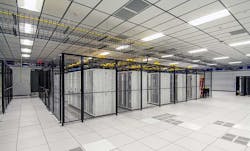Compass Datacenters has begun construction on a major new campus in Goodyear, Arizona, which has quickly emerged as a hot destination in the Phoenix data center market.
Compass said Tuesday that it has started work on two data centers that will deliver a combined 72 megawatts of IT capacity, and expects to complete the buildings before the end of 2019. The master plan for the first phase of the campus calls for 144 megawatts of IT load, with the opportunity for growth up to 350 megawatts with an on-site 230kV substation. Data Center Frontier first reported on Compass’ plans back in January.
“Greater Phoenix is a natural next step for Compass since it’s an important location for cloud and hyperscale customers, due to its geographic location, availability of fiber connectivity, affordable cost of data center operations, and the rarity of natural disasters,” said Chris Crosby, CEO of Compass. “We have been working closely with a number of cloud, colocation, and hyperscale customers on data center projects on our campuses.”
The Phoenix data center market is in the midst of a data center building boom, and is drawing some of the biggest names in hyperscale computing. Phoenix is the fifth-largest market for data center capacity in the U.S., trailing Northern Virginia, Silicon Valley, Dallas and Chicago.
Data center developers have announced plans for more than 1 gigawatt of capacity for the area, more than any market in the U.S. except Northern Virginia.
A Good Year to be Goodyear
“Greater Phoenix is rapidly becoming a leading market for data centers in the U.S.,” says Chris Camacho, president and CEO of the Greater Phoenix Economic Council. “The region’s ideal southwest location offers very low risk of natural disasters, low latency, robust infrastructure and close proximity to a broad customer base. Data drives innovation, and we’re excited that Compass Datacenters selected Goodyear, Arizona as the next step for their strategic company growth.”
The small town of Goodyear has emerged as a data center destination. In addition to Compass, Microsoft recently bought land in Goodyear for a major cloud availability zone, while Stream Data Centers and Vantage Data Centers also own land in Goodyear for future campuses.
An illustration of the future Compass Data Center campus in Goodyear, Arizona. (Image: Compass Datacenters)
“Compass Datacenters is a world-class company and a magnificent addition to our growing technology base,” said Goodyear Mayor Georgia Lord. “The city has worked tirelessly with Compass on this multi-parcel, multi-owner land transaction in an effort to provide our community with high-end jobs and high-tech solutions. Goodyear is quickly becoming a dynamic location for tech companies and knowledge workers. We are excited to have Compass as a valued partner in this re- hot market.”
Your Data Center, Your Way
The Compass executive team has built more than $4 billion worth of data centers and edge computing facilities, and operated over 10 million square feet of raised floor worldwide.
Compass pursues a campus strategy, enabling customers to easily expand in phases to add additional capacity as demand dictates. The company describes its designs as “Your Data Center, Your Way.” Tenants can choose from a menu of options to personalize each facility, with choices on the site, building, data hall, mechanical/electrical infrastructure, security and the building management system. This approach has made it popular with service providers like TierPoint, Windstream and Iron Mountain, which have all partnered with Compass to develop stand-alone facilities.
“The flexibility of our data center design along with our patented delivery methodology enables us to deliver just-in-time facilities customized to their specific requirements,” said Crosby. “These data centers will allow customers to reduce their on-going operating costs and will provide them with complete control over every element of the building – including security, campus network connectivity, operations and maintenance – all on the aggressive timeline they demand.”
In the Compass design, the entire building is precast, allowing Compass to go from foundation to a completed building framework in 18 to 21 days, including the roof. Each power room is pre-fabricated and then attached to the building. The cooling infrastructure employs the Kyoto Cooling heat wheel (also known as a rotary heat exchanger) attached to the rear of the building.






